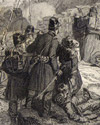19th Century´s militar history in the Basque Country
THE FRENCH FOREING LEGION
 By the Quadruple Alliance Treaty signed in April 1834, France and Great Britain agreed to support the Liberal governments of Portugal and Spain in their respective civil wars. In August 1834, Spain added a clause to this Treaty whereby France agreed to close the border to the Carlists. However, this proved not to be enough and in 1835, the government of Martínez de la Rosa requested the direct dispatch of troops. Both the French and the British tried to avoid direct participation in the Carlist war by sending special troops of volunteers or, in the French case, the Foreign Legion.
By the Quadruple Alliance Treaty signed in April 1834, France and Great Britain agreed to support the Liberal governments of Portugal and Spain in their respective civil wars. In August 1834, Spain added a clause to this Treaty whereby France agreed to close the border to the Carlists. However, this proved not to be enough and in 1835, the government of Martínez de la Rosa requested the direct dispatch of troops. Both the French and the British tried to avoid direct participation in the Carlist war by sending special troops of volunteers or, in the French case, the Foreign Legion.
These troops were picturesque adventurers of diverse nationalities who had been hardened by the war in Algeria and were subject to an iron hand. On the 27th of June 1835, the 5,000 men in the French Legion left Algiers and, following a quarantine period in Mallorca, arrived in Tarragona on the 16th of August.
The commander of the Legion was General Bernelle, a man with a rather weak personality. In fact, the real leader of these troops was his second-in-command Joseph Conrad, an Alsace official who was much loved and admired by his men, and who lost his life in Barbastro, in May 1837, trying to prevent his legionnaires from running away during a Carlist offensive.
 The first action in which the French Foreign Legion took part was that of the Castle of Guimerá (Lleida), in September 1835. After the 80 Carlists defending the castle surrendered, the Legion proceeded to executed them. Because of this, the Carlists never showed the Legion any mercy and shot every member that fell into their hands.
The first action in which the French Foreign Legion took part was that of the Castle of Guimerá (Lleida), in September 1835. After the 80 Carlists defending the castle surrendered, the Legion proceeded to executed them. Because of this, the Carlists never showed the Legion any mercy and shot every member that fell into their hands.
In December 1835, the Legion moved to Sangüesa and then, at the start of the following year, to Vitoria. They immediately joined the British Auxiliary Legion in the action at Arlabán, where they lost many men and were forced to return to Alava.
In 1836, the French Foreign Legion was plagued with difficulties, such as a lack of provisions and clothes, and late payments. This meant that losses caused by casualties in combat, leave, and the many desertions could not be covered. So many legionnaires passed over to Carlist lines that a battalion of 850 of the deserters called the Batallón Argelino (Algerian Battalion) was formed.
 In March 1837, the Foreign Legion fought the Carlists in Larrainzar and Dos Hermanas. Two months later, during the Royal Expedition, the battles of Huesca and Barbastro took place - the latter was particularly savage for the Legion as it had to face its deserters in the Batallón Argelino. It lost Conrad in the battle, which brought about the Legion's virtual disappearance.
In March 1837, the Foreign Legion fought the Carlists in Larrainzar and Dos Hermanas. Two months later, during the Royal Expedition, the battles of Huesca and Barbastro took place - the latter was particularly savage for the Legion as it had to face its deserters in the Batallón Argelino. It lost Conrad in the battle, which brought about the Legion's virtual disappearance.
In July, the Legion was reorganised and both the cavalry and the artillery were incorporated into the Spanish army, while the rest of the Foreign Legion suffered an agonising time until it was finally dissolved in December.

